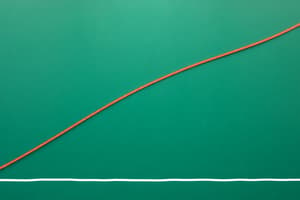Podcast
Questions and Answers
What happens to the average cost of production when a firm increases its scale of production to realize economies of scale?
What happens to the average cost of production when a firm increases its scale of production to realize economies of scale?
The average cost of production decreases.
What is the point at which a firm's total revenue is equal to its total cost?
What is the point at which a firm's total revenue is equal to its total cost?
The break-even point.
What is the goal of a firm in a perfect competition market?
What is the goal of a firm in a perfect competition market?
To maximize profit.
What is the supply curve of the firm?
What is the supply curve of the firm?
What is the difference between normal profit and economic profit?
What is the difference between normal profit and economic profit?
What happens to the marginal productivity of a variable input when the law of diminishing returns is applied?
What happens to the marginal productivity of a variable input when the law of diminishing returns is applied?
What is the effect of an increase in the scale of production on the firm's average cost?
What is the effect of an increase in the scale of production on the firm's average cost?
What is the role of the price taker in a perfect competition market?
What is the role of the price taker in a perfect competition market?
What is the purpose of the shut-down rule?
What is the purpose of the shut-down rule?
What is the industry equilibrium?
What is the industry equilibrium?
Flashcards are hidden until you start studying
Study Notes
Long-run Equilibrium of the Firm and Industry under Perfect Competition
- Long-run equilibrium of the firm and industry under perfect competition occurs when the firm and industry are in equilibrium at the same time.
- This equilibrium is achieved when the firm earns a normal profit and there is no incentive for new firms to enter or existing firms to exit the industry.
The Firm in Long-run Equilibrium
- In long-run equilibrium, the firm produces at the minimum point of the average cost curve.
- The firm's marginal cost (MC) equals its marginal revenue (MR).
- The firm's average cost (AC) equals its average revenue (AR).
- The firm earns a normal profit.
Industry in Long-run Equilibrium
- In long-run equilibrium, the industry is in equilibrium when the quantity supplied by the industry equals the quantity demanded by the market.
- The industry supply curve is horizontal, indicating that the industry is perfectly competitive.
Impact of Entry and Exit on Equilibrium
- Entry of new firms into the industry leads to an increase in the industry supply, causing a decrease in the market price.
- Exit of firms from the industry leads to a decrease in the industry supply, causing an increase in the market price.
- The process of entry and exit leads to the long-run equilibrium of the industry.
Important Concepts
- Market structure: Perfect competition, monopoly, monopolistic competition, oligopoly.
- Perfect competition: Many firms producing homogeneous products, free entry and exit, and perfect information.
- Shut-down rule: A firm shuts down if the price is less than the average variable cost.
- Profit-maximising rule: A firm produces where marginal cost equals marginal revenue.
- Total cost (TC), average cost (AC), average variable cost (AVC), marginal cost (MC), total profit, normal profit, economic profit, break-even point.
Studying That Suits You
Use AI to generate personalized quizzes and flashcards to suit your learning preferences.




